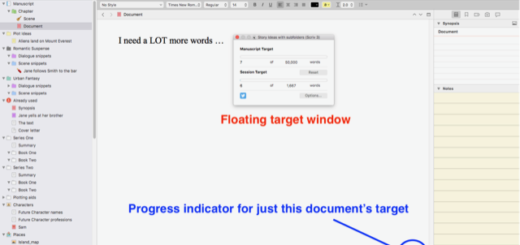Apps to Keep Your Writing on Track by Vanessa Kier
 Let’s welcome back monthly columnist, Vanessa Kier as she shares with us “Apps to Keep Your Writing on Track.” Enjoy!
Let’s welcome back monthly columnist, Vanessa Kier as she shares with us “Apps to Keep Your Writing on Track.” Enjoy!
***
One of the best ways to stay motivated as a writer is to track your progress. If you’ve been tracking your progress, then whenever that annoying voice of doubt whispers that you’re never going to finish this book and you might as well give up, you can point to the proof and shut that voice right up.
Setting small, achievable goals taps into our innate need for positive reinforcement. Each time you complete a goal, you reinforce the feeling of success. And success breeds more success.
There’s an App for That
You can track your progress on paper to-do lists or calendars.
That’s how I tracked my progress when I first committed to writing seriously. I wrote my daily word count on a calendar I’d printed out.
However, if you’re going to write when you’re not near your desk or calendar, then it’s handy to use an app to track your progress.
The other advantage of using an app is that some of them offer pretty graphs or charts. I love seeing my progress represented in a graphic versus a list of numbers.
Make Writing a Habit
No, you don’t have to write every day. But the majority of successful writers finished their books because they wrote consistently.
So, figure out how often you can sit down to write, then set that as a goal.
Maybe you work full-time and will write for two hours on Saturdays and Sundays.
Maybe you’ll write for half an hour Mondays-Wednesdays-Fridays. Whatever it is, commit to a regular schedule.
What digital tools can help you achieve this goal?
Your calendar app. Whether you use Google Calendar, the Calendar app on your Apple devices, or a third party calendar, set up your writing times as appointments. Don’t forget to add reminders to these appointments. Once you’ve completed that day’s task, add DONE or some other motivational word to the name of each individual appointment.
A to-do app. Get a to-do app and set your writing dates up as recurring tasks. I like the Alarmed app on my iPhone because not only can I set recurring tasks, but it will nag me every half hour until I check a task as completed.
A habit-stacking app. Use a habit stacking app such as Strides (iOS and web) or Goal Tracker & Habit List (Android).
Habit stacking is the premise that if you take small steps every day, you will eventually turn those steps into a habit.
Strides isn’t aimed specifically at writers, but you can use it to set a writing goal, the frequency of that goal, then mark whether or not you completed the task on the allotted day.
Here’s a screenshot that shows how simple it is to mark Yes/No regarding whether you completed the task on a particular day.
This is a demonstration goal I set up for a writer who is going to write Mondays-Wednesdays-Fridays during November.
And here’s the graph showing the overall progress:
Word Count
Many writers, myself included, track how many words we write.
Not only does this show me how close I am to my desired total word count for the book, but I feel a strong sense of satisfaction when I see each day’s total. And yes, I have to admit to being super competitive. I like beating my previous word counts.
Most software programs aimed at writers, such as Scrivener or Storyist, have built-in word count tracking. Once you set a target for your total word count, there’s usually some form of graph or progress bar to show you how you’re doing.
One of the features I love the most about Scrivener 3 is that the new writing history feature keeps track of my writing by date and total words written. I love being able to see which days were most productive.
If your writing program doesn’t add up new words for you, you can create a spreadsheet to track your word count.
These spreadsheets were set up for writers participating in NaNoWriMo. They show your running word count total and the number of words left to write of the 50,000 overall word count. Before Scrivener 3 came out, I modified the spreadsheet to track my progress toward my usual target of 100,000 words.
There are also word count tracking apps available for mobile devices. Do a search on “word count” in your app store.
Some of these apps only count the total number of words after you paste in text, but there are some apps, such as Word Keeper (iOS) or Novel Word Count (Android) where you can input and track your daily word count and see the results in pretty graphics.
Don’t Get Off Track
Whether you decide to stick to pen and paper or try one of the apps listed above, stay motivated by tracking your writing progress. By the end of the year, you’ll be surprised at how far you’ve come.
Have a favorite app for tracking your progress? Let me know in the comments below.
Until next time, Happy Writing!
***
ABOUT THE AUTHOR
 TEACHER/TECH SPECIALIST FOR WRITERS/NOVELIST
TEACHER/TECH SPECIALIST FOR WRITERS/NOVELIST
Vanessa Kier combined her love of teaching and her fascination with technology to form The Writer’s Tech Stop https://thewriterstechstop.com, where writers can get coaching, classes, and services related to Scrivener and other writer-related tech. She also writes action-packed romantic thrillers with an edge. https://www.vanessakier.com. When not working, she likes to take long hikes in the local hills, play puzzle games on her mobile device, and read.
***
If you’d like to get started on Scrivener to write your novel, check out the training Vanessa Kier did for us here.
***








